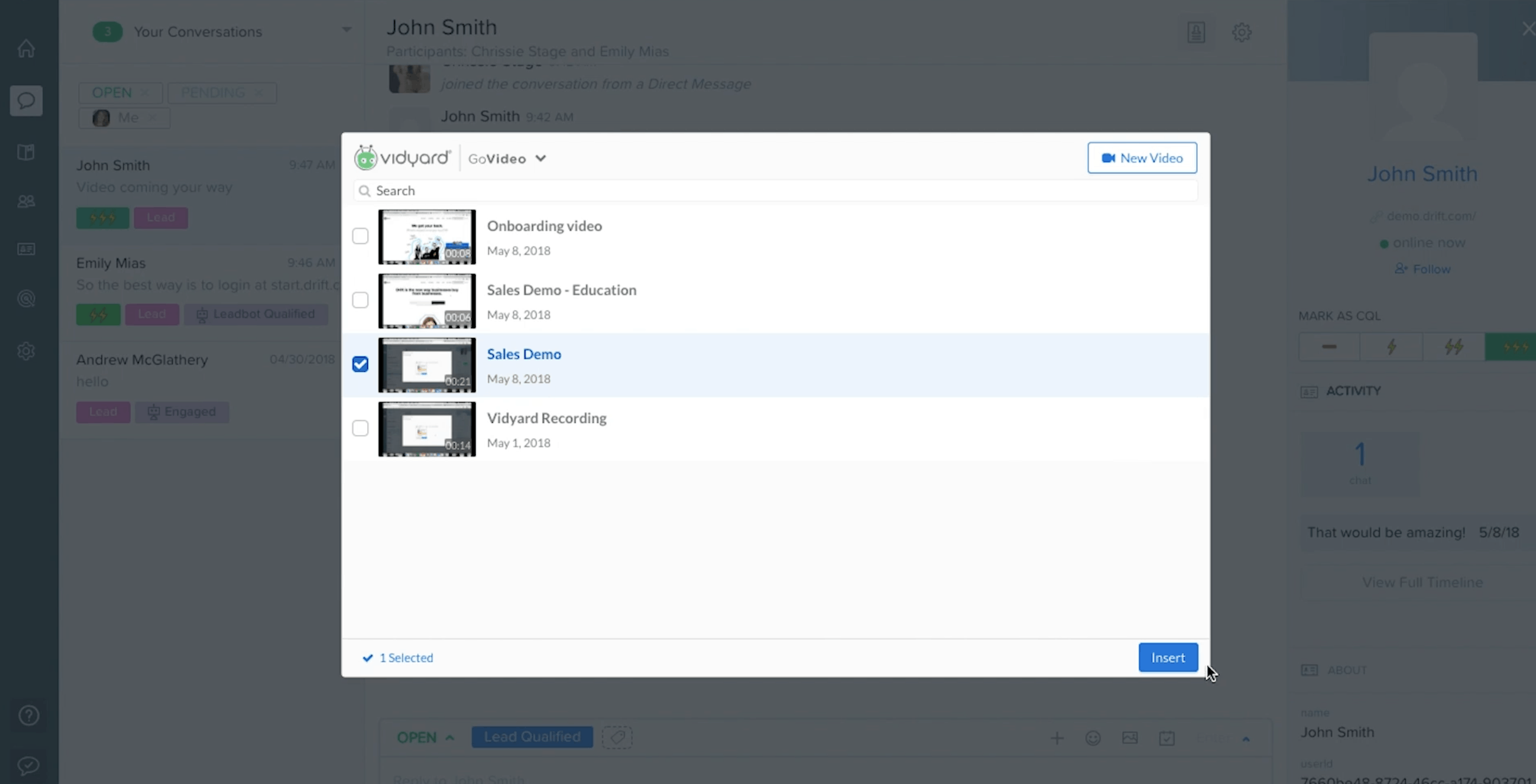
The next generation of B2B buyers will shop for software in an entirely different way than most decision-makers do now.
Why?
Put simply, times are changing. As a marketer coming up in the space myself, I see first-hand how consumer buying experiences are influencing the way I look at B2B tools.
Take, for example, an experience I had while shopping on Everlane recently. I was browsing their site looking for a new jacket for the dismal, New England spring weather that we’re accustomed to here in Boston.
Not only was Everlane’s clothing beautiful, but their shopping experience was on ?. It was so good that it made me wonder why we don’t use the same tactics in B2B sales and marketing.
So, what did they do to make the buying experience so memorable?
- They gave me unfettered access to the product. Their product pages gave me detailed information and showed what the jacket looked like on a variety of body types. The shopping experience felt far from one-size-fits-all. Even though it was online, it felt personalized to me.
- They made a connection with me that was bigger than their product. Using phrases like, “radical transparency” and “simple basics sourced from ethical materials” they told me exactly how their products are made and made me feel like I was joining them in a movement to push towards a more sustainable future.
- They made themselves available to chat. If you follow Everlane on social you know that they’re constantly asking their customers for feedback and looking to chat. Upon reaching out to them with a sizing question they immediately responded — giving me confidence in their brand.
That’s pretty darn amazing.
So, why am I talking about a B2C experience on a blog for B2B marketers?
Because B2B buyers coming up today are starting to demand experiences that feel more and more like B2C.
Yet, in most cases, in B2B, we’re not listening. Instead, we’re doing things that are the opposite of memorable: gating content with forms, and forcing people to endure endless, impersonal email campaigns.
The list goes on, but the takeaway remains clear: the B2B sales process has got to change.
And not just because it doesn’t work now, but it’ll be outright rejected by the B2B buyers of the future.
The Consumerization of B2B and Why Businesses Need to Start Paying Attention
So why even talk about this? Because we marketers need to do better.
We’ve been lead to believe that there’s this gulf of difference between B2C and B2B buyers that’s no longer relevant today. In reality, we’re all simply people buying from people.
The Shift in B2B Buying Expectations
Let’s think back to the Everlane story for a minute.
Another reason why it worked so well for me — a twenty-something B2B marketer — is because they eliminated any potential friction in the buying process. They made it easy to imagine myself using the product, and made it fun to buy. If B2B businesses want to win the hearts, minds, and wallets of future buyers, they’ve got to take note and shift their B2B sales techniques.
Forrester’s Andy Hoar puts it best when he says:
“It’s not as though you have a B2C consumer experience that blows you away on Amazon, or Nordstrom, or Sephora, or Charles Schwab – or wherever you’re going to go – and then, all of the sudden, go to work and say, ‘Well, now I expect a much worse customer experience, and I’m happy with that.”
^ He hits the nail on the head. It’s exactly because of this that buyers are bringing B2C expectations to B2B.
But if more and more B2B buyers want to have better experiences, what’s standing in the way? Let’s unpack the obstacles.
Why B2B Struggles to Adapt to A New Era of Marketing and Sales
To make these changes as a B2B company, you may be thinking, I should just leverage the tried-and-true B2C tactics for B2B — it’s a simple plug-and-play. Sounds easy, right?
Well, not quite.
Businesses struggle to implement B2C best practices based on three key beliefs:
1. B2B is often far more complex than a consumer purchase.
Think back to the last time you had to evaluate a piece of software or hardware for your company. I bet it wasn’t that easy.
You likely had to: 1.) sift through data from a large number of providers to create a pool of prospect lists, 2.) sign up for more sales meetings and demos than you care to remember, and 3.) jump through numerous hoops to get all the right stakeholders in the room at the same time.
Then, once all the meetings were had, you signed your name on the dotted line, locking you into a very expensive contract for a year (or maybe longer). Sound familiar?
Thing is, it doesn’t have to be this way.
Sure, the current B2B process is complex, but that’s because we’ve made it that way. By implementing a customer-centric buying process and using real-time selling, people get the answers they need, when they need them, and can make decisions more quickly and easily.
2. Marketers still don’t understand how to manage B2B lead response times.
I’ve seen B2B marketers engage with leads on their sites in two main ways:
- They have someone fill out a form in exchange for chatting with a sales rep at some point in the future.
- Leads come to site to view a piece of high-value content, but then have to enter their email address to actually read it.
But, here’s the problem: Using these methods, marketers typically don’t engage with hot leads fast enough to keep them interested in the product. And that’s a massive mistake.
The truth is: B2B marketers face a huge struggle with response times.
In fact, when we tested the response time of 512 B2B companies, we found that only 42% of marketers responded to a hot lead within a five-day timeframe. Even worse, 58% never responded at all.
The solution: Take a cue from the B2C space and learn how to do B2B sales the right way. By opting for conversation and real-time selling over forms and gated content, marketers and salespeople are able to immediately engage with hot leads — and close deals faster.
3. The funnel is becoming less and less linear.
Ask any of your prospects how they buy, and more than likely, they’ll tell you how they spend time looking at reviews and chatting with people at other companies who use a similar product to the one they’re looking for. They have conversations, reach out on social, check out sites like G2 Crowd, and reach out when they’ve decided it’s time to buy or have questions. It’s a non-linear process.
But too many B2B companies still treat the sales process as if it were a neat funnel. And that’s a mistake.
Today’s buyers aren’t going to reach out in the way *you* want them to — so why not build a sales process that meets your buyers *where they are*? With conversational marketing tools, it’s a ton easier to do this. Allow prospects to chat with you 1:1 when they land on your site. Remove the burden of providing contact details from the buyer to your conversational marketing platform.
Put simply, just build a buying process that puts buyers’ needs first. It might feel like a lift up-front, but it pays high returns down the road.
In fact, a report by McKinsey showed that businesses that did this saw a 20% increase in customer leads and a 10% growth in first-time customers.
Even more telling? The results Drift customers are seeing after implementing a conversational marketing approach. Only three months after switching to Drift, MongoDB saw net new leads increase by 70%, and opportunities increase by 170%. And ThriveHive shortened their sales cycle from an 11-day average to a 4-day average.
So how else can you implement a modern B2B sales process?
Meet buyers where they’re at (and then do things that don’t scale). Take a look under the hood of your organization and break down each of your customer segments, charting what each of their buying journeys looks like. Then, meet your customers where they’re at by using real-time conversation to engage with them and answer their questions. Think personalized emails, responses on social, and real-time messaging on your website.
Good example: Sometimes people think conversations don’t scale. But here at Drift, our sales reps aren’t only on the phone they’re also on our website, having conversations with visitors about our products and services — without them having to book a demo first. We have 1:1 conversations — and even send personalized videos to our prospects to humanize sales reps.

Push sales reps further up in the funnel. Don’t wait for perfect marketing and sales alignment — get reps into the conversation sooner and show them how to engage buyers. By increasing the collaboration between marketing and sales, you’ll drive success.
Here’s a story for you. I recently overheard a member of our sales team, Scott Schacter, talking about how he closed a deal, while chilling on his couch, after so-called “business hours”. Sounds a little unconventional, right? Allow me to unpack the details.
Scott had sent an email to the company’s SVP of Marketing. Rather than respond, the SVP of Marketing forwarded the email to John, the company’s Director of Website Optimization and asked him to take a look. When John came to the Drift site, Scott received a notification, the Drift chatbot did its work, and the two immediately hopped on the phone and had a real-time conversation.
Without the chatbot letting Scott know that John was on site, and John instead being passed to marketing as a qualified lead, both teams could’ve missed the sale.
Change your metrics. B2B sales teams are often hyper-focused on the number of deals they’ve closed, not on their ability to successfully engage with and answer prospects questions. Change your B2B sales training to measure your sales team’s conversations versus just conversions.
Start by optimizing for conversations in the marketing outreach you’re already doing.
For example, every day my inbox gets flooded with tons of messages from companies that use generic reply-to email addresses. What happens if I actually wanted to respond and ask about a product or set up a sales demo? I’d be out of luck, since most email replies to generic mailboxes simply end up getting stashed into a folder — and that’s a problem that should be frustrating for both the buyer and the seller.
Instead, make it easy for your customers to start conversations by sending emails from a real person on your team. Then, measure and monitor the success of your emails using your response rate.
Go-Real Time to Engage Prospects and Close More Deals
B2B buyers are having amazing consumer experiences, and it’s changing their expectations for buying business software. Businesses can either adapt or risk falling behind competitors who already see how the market is shifting. By leveraging a conversational approach and real-time messaging, smart sales organizations will capitalize on this trend, and convert leads into customers more quickly.



